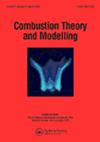后向阶跃燃烧室预混燃烧临界减速实验研究
IF 1.6
4区 工程技术
Q4 ENERGY & FUELS
引用次数: 0
摘要
临界减速现象发生在各种动力学状态的过渡过程中,如分叉。动力系统的本征值可以看作是即将分岔临界减速的一个指标。自适应局部线性模型可以通过将全时序列分割成多个窗口来提取非线性动力系统的局部特征值,特征值谱分析是基于这些特征值的。不同燃烧状态之间的状态转换通过分叉过程发生。本文研究了后向台阶燃烧室分叉过程中的临界减速问题。我们通过固定空气质量流量和改变燃料质量流量,从稀薄井喷状态到具有准稳态变化的热声不稳定状态进行了一系列实验,燃烧状态随运行条件的变化呈现出准Hopf分岔过程。采用局部线性模型对实测压力波动进行处理,分析其特征值谱。当当量比增加时,特征值的实部逐渐接近零,这种趋势对应于临界减速。此外,常用的预警信号也用于支持特征值谱的分析结果。本文章由计算机程序翻译,如有差异,请以英文原文为准。
Experimental investigation on critical slowing down of premixed combustion in a backward-facing step combustor
Critical slowing down phenomena occur during the transition process of various dynamical states, such as bifurcations. The eigenvalues of dynamical systems can be regarded as an indicator of critical slowing down of impending bifurcation. Adaptive, locally linear models can extract local eigenvalues of the nonlinear dynamical system by segmenting a full-time series into multi-windows, and eigenvalue spectrum analysis is based on the eigenvalues. The state transition between different combustion states occurs through bifurcation processes. In this paper, we investigate critical slowing down in the bifurcation process of backward-facing step combustor. We performed a series of experiments by fixing the air mass flow and varying the fuel mass flow from the lean blowout condition to a thermoacoustic instability condition with a quasi-steady change, and the combustion state varying versus the change of the operation conditions exhibit a quasi-Hopf bifurcation process. The measured pressure fluctuations were treated by the local linear model to analyse the eigenvalue spectrum. The real parts of the eigenvalues approximate zero gradually when the equivalence ratio increases, and this tendency corresponds to the critical slowing down. Furthermore, the commonly used early warning signals were also used to support the analysis results of the eigenvalue spectrum.
求助全文
通过发布文献求助,成功后即可免费获取论文全文。
去求助
来源期刊

Combustion Theory and Modelling
工程技术-工程:化工
CiteScore
3.00
自引率
7.70%
发文量
38
审稿时长
6 months
期刊介绍:
Combustion Theory and Modelling is a leading international journal devoted to the application of mathematical modelling, numerical simulation and experimental techniques to the study of combustion. Articles can cover a wide range of topics, such as: premixed laminar flames, laminar diffusion flames, turbulent combustion, fires, chemical kinetics, pollutant formation, microgravity, materials synthesis, chemical vapour deposition, catalysis, droplet and spray combustion, detonation dynamics, thermal explosions, ignition, energetic materials and propellants, burners and engine combustion. A diverse spectrum of mathematical methods may also be used, including large scale numerical simulation, hybrid computational schemes, front tracking, adaptive mesh refinement, optimized parallel computation, asymptotic methods and singular perturbation techniques, bifurcation theory, optimization methods, dynamical systems theory, cellular automata and discrete methods and probabilistic and statistical methods. Experimental studies that employ intrusive or nonintrusive diagnostics and are published in the Journal should be closely related to theoretical issues, by highlighting fundamental theoretical questions or by providing a sound basis for comparison with theory.
 求助内容:
求助内容: 应助结果提醒方式:
应助结果提醒方式:


